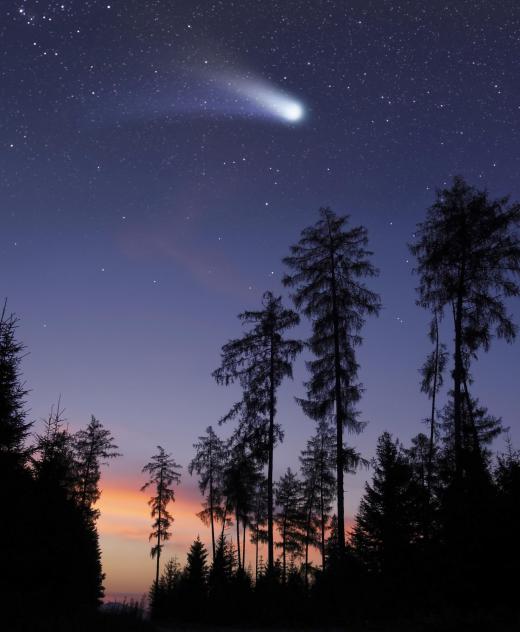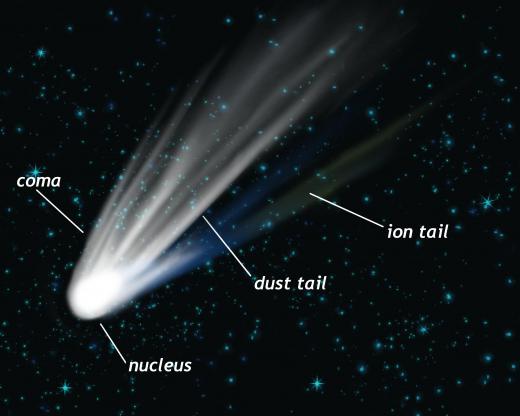What is a Comet?
 Tricia Christensen
Tricia Christensen
A comet is a small astral body, similar in construction to a planet. Its orbit may at times bring it close to the sun and make it visible to the naked eye, or through relatively low strength telescopes, from Earth. When one can be viewed, it is usually noted as having a tail, made of gasses, which early astronomers often mistook for a shooting star.
Most observable comets in our solar system derive from the Oort Cloud, a hypothesized cloud made up of leavings from the sun. These materials form comets, which orbit the sun because they are affected by its gravitational pull. While passing by individual planets, the comet may be affected by the gravitational forces of the planets, thus causing an elliptical or oval-type orbit.

Usually, people on Earth see these astral bodies when they passes in between Earth and the sun. It is thought that the comet and its tail, sometimes called the coma and tail, reflect the light of the sun, enhancing their visibility. Since comets may orbit the sun in strange patterns, people may only see the passage of one in a lifetime.
In fact, comets are usually classed by the length of time it takes them to orbit the sun. A short period one takes up to about 200 years to make a full trip around the sun. A long period comet may take far more time to complete a trip.
For example, Halley’s Comet can be viewed on earth about every 75 years, which makes it part of the short period class. Its last sighting on Earth was in 1986, and it is expected to be seen again in 2061.

A planet may capture a comet, which can cause significant damage to the astral body. Such a gravitational capture may cause it to break into many small pieces, which can then hit the capturing planet. Comet Shoemaker-Levy 9 was observed as broken in 1993, and astronomers were able to witness it hitting the atmosphere of Jupiter in 1994.
Most often, people looking at the night sky may think that they see “falling stars” that are actually meteors or comets. There are thousands of tiny ones that do not attract much interest. The once in a lifetime comets like Halley’s are often thought of as exciting, since most people will only see them with the naked eye once.
AS FEATURED ON:
AS FEATURED ON:














Discussion Comments
I know movies have depicted these cataclysmic events, but how do we know these are accurate depictions of what would happen in a comet strike?
The only instance that mass damage was measured from what is believed to be a comet strike happened in Siberia around 1908 or 1909 and it took out several square miles and has still boggled the minds of scientists to this day, who wonder if it is even a comet strike or not.
I have to wonder if there are other instances of comet strikes or if they are that uncommon that scientists do not even know if it was a comet strike or not?
I am guessing that those that appreciate the sky look for anomalies, such as comets, and it gives them something else to look at in the sky.
However, those who are not appreciative of inter stellar events would look at a comet and just think that it happens every so often, so it is nothing special in the large scheme of things.
What people need to realize is that comets are amazing events and it puts the Earth into perspective as if it were to be struck by a comet it would be a world wide catastrophe, but we are lucky enough to see one from a safe distance.
In my lifetime I have not seen Haley's comet and will not until I am 75 years old, but I have seen other less famous comets that varied in their orbit of the Earth.
Where I live, there is a comet that circles the Earth and becomes visible once every 3 to 5 years and there have been others that have come by that may never be visible again or will not be seen for tens of thousands of years.
I have always been interested in comets and how they are anomalies in the sky.
I know that it is an uncommon events to see a comet, as one will become visible once every few years, no matter where someone is at in the world, and each one that goes by tells a different story and circles the Earth at different times.
I am doing a project about comets. Thanks for the information about it!
Can anyone explain if there a plan for a newer voyager model and when was the first one used?
Aren't there a lot of different superstitions and folklore stories around comets? I'd be really interested to hear some of them from around the world if anyone wants to share!
Post your comments